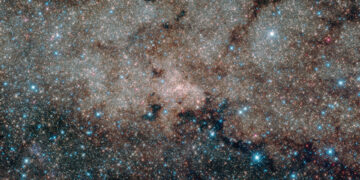Imagine a universe where every atom of carbon, the building block of life, takes part in a grand journey spanning eons. Recent discoveries have revealed the extraordinary mechanics behind this voyage, offering insights into the nature of galaxies and the origins of life itself. This process, known as the circumgalactic medium (CGM), serves as a cosmic conveyor belt, ensuring the continual recycling of elements across the universe.
The Stellar Origins of Carbon: A Tale of Creation
Stars are the factories of the universe, forging elements that shape worlds and life.
In their fiery cores, stars create elements heavier than hydrogen and helium through nuclear fusion. When they die, they unleash these treasures into space via supernovae, dispersing carbon, oxygen, and other life-essential elements. This process, aptly described as cosmic recycling, ensures that galaxies like ours continually form new stars and planets.
A recent study from researchers at the University of Washington confirms this process, emphasizing that the carbon found in our bodies likely spent millennia cycling through intergalactic space.
Unveiling the Circumgalactic Medium: The Universe’s Recycling System
The circumgalactic medium is not just a feature of galaxies; it is their lifeline.
This massive halo of gas, which can extend up to 400,000 light-years, acts as a galactic reservoir. Researchers describe it as a “train station,” where elements are pushed out of galaxies during supernova explosions and eventually pulled back in. These materials, once ejected, traverse the intergalactic void before gravity and other forces reel them back, forming the next generation of stars and planets.
Using the Hubble Space Telescope’s Cosmic Origins Spectrograph, scientists observed this process in action. They measured how light from nine distant quasars was absorbed by carbon within the CGM of 11 star-forming galaxies. This revealed carbon currents stretching far beyond the galaxies themselves, confirming the CGM’s role as a conveyor belt for essential elements.
The Long Journey of Carbon: From Stars to Galaxies
Carbon’s path through the CGM is both dynamic and intricate.
Unlike the previously assumed aimless drift, carbon follows structured currents that eject it far into space before it circles back. Researchers identified that carbon exists in both hot and cold forms within the CGM, expanding our knowledge of its versatility.
Lead researcher Samantha Garza compares the CGM to a galactic ecosystem, where “heavy elements get pushed out of their host galaxy through supernova deaths, only to return later to fuel new formations.” This cyclic behavior ensures that galaxies maintain a steady supply of carbon, which is critical for forming stars, planets, and potentially life.
Implications for Galaxy Evolution and Star Formation
The recycling of carbon is more than a galactic feature—it’s a survival mechanism.
Galaxies that rely on the CGM for replenishment can sustain star formation for billions of years. However, when this cycle slows or breaks down, galaxies transition into inactive “stellar deserts,” where star formation ceases.
Jessica Werk, a co-author of the study, highlights the CGM’s pivotal role in galaxy evolution: “If you can keep the cycle going—pushing material out and pulling it back in—you have enough fuel to sustain star formation indefinitely.”
Cosmic Recycling and the Origins of Life
The carbon cycle within the CGM is not just an astronomical phenomenon; it’s a clue to our origins.
The elements dispersed by stars and recycled through the CGM eventually form the building blocks of life. From the iron in Earth’s core to the carbon in living organisms, these materials are products of a vast, interconnected cosmic system.
Conclusion: A Cosmic Cycle That Shapes the Universe
The discovery of the CGM’s role as a cosmic conveyor belt is a testament to the universe’s intricate design.
By recycling carbon and other elements, the CGM ensures that galaxies remain dynamic and capable of sustaining star formation. This process underscores the interconnectedness of the cosmos, from the fiery deaths of stars to the emergence of life on planets like Earth.



















